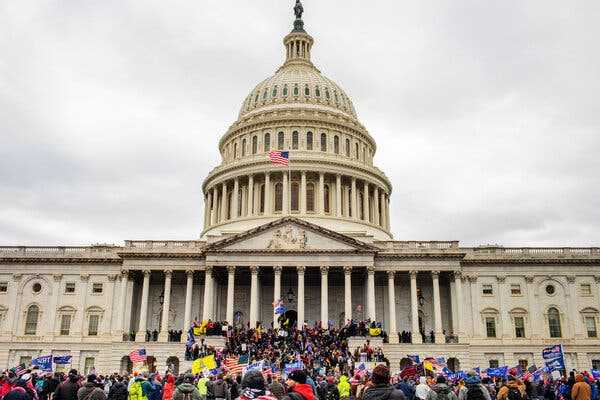The four members of the far-right militia were found guilty of seditious conspiracy nearly two months after the group’s leader, Stewart Rhodes, was convicted of the same charge in a separate proceeding.
-
Send any friend a story
As a subscriber, you have “>10 gift articles to give each month. Anyone can read what you share.
Give this articleGive this articleGive this article

Federal prosecutors argued that several Oath Keepers members had positioned themselves in Washington on Jan. 6, ready to back President Donald J. Trump as an armed militia.
WASHINGTON — Four members of the far-right Oath Keepers militia were found guilty of seditious conspiracy on Monday for their roles in trying to keep Donald J. Trump in office after his 2020 election defeat, nearly two months after the group’s leader — Stewart Rhodes — was convicted of the same offense in a separate trial in November.
A jury in Federal District Court in Washington also found the four defendants guilty of two separate conspiracy charges.
The defendants — Roberto Minuta, Joseph Hackett, David Moerschel and Edward Vallejo — were originally charged along with Mr. Rhodes and other members of the group. But their trial was broken off as a separate proceeding by the judge in the case, Amit P. Mehta, because of space constraints in the courtroom.
On Jan. 6, 2021, Mr. Minuta, Mr. Hackett and Mr. Moerschel joined others in the group in forcing their way inside the Capitol, while Mr. Vallejo, who was stationed in a hotel room stocked with rifles in Virginia, sent frequent texts offering to ferry weapons into the city if needed.
The jury returned the decision after about 15 hours of deliberation over three days, and it came as a parallel sedition trial for members of the Proud Boys — another far-right group that joined the mob outside the Capitol on Jan. 6 — continued to play out in the same courthouse.
The earlier trial of members of the Oath Keepers resulted in a more mixed outcome, with two of five defendants, Mr. Rhodes and a longtime ally, Kelly Meggs, found guilty of seditious conspiracy, the most serious charge. The jury in the earlier case acquitted Mr. Rhodes of two separate conspiracy charges.
The government depicted the defendants in the second trial as lower in the organization’s power hierarchy than those in the first case, and more readily employed as foot soldiers for the group than as top operational coordinators.
Prosecutors had argued that on the day of the riot, Mr. Hackett and Mr. Moerschel joined a group of 12 others as the “boots on the ground,” forcing their way into the Capitol on Jan. 6 with “brute strength.”
They said that Mr. Minuta, a New York tattoo artist, followed shortly behind with a separate group that clashed aggressively with Capitol Police officers inside. Earlier that day, Mr. Minuta and his group had provided security for Roger J. Stone Jr., a former adviser to Mr. Trump, and rushed to the Capitol on a golf cart to join the mob and confront police officers.
“To Minuta and these people storming into the Capitol, they were patriots,” Troy Edwards, a prosecutor, told the jury at the beginning of the trial. “And he was headed to join what he called patriots.”
Federal prosecutors described how Mr. Vallejo, an Army veteran from Arizona, kept watch over an arsenal of guns stashed in a hotel in Virginia as part of a “quick reaction force” that could deliver weapons to those members in Washington in the event of a breakdown in the rule of law.
They also returned to some of the evidence presented in the case against Mr. Rhodes last year, poring over reams of text messages in which members of the group fretted over Mr. Trump’s fate after the election and swapped outlandish conspiracies about Joseph R. Biden Jr. and what they described as shadowy international forces influencing him.
Over the course of both trials, lawyers for the Justice Department argued that the Oath Keepers had for months expressed a desire to help Mr. Trump remain in power even after his election loss, and that they had positioned themselves in Washington on Jan. 6, ready to back the president as an armed militia if Mr. Trump authorized them to.
“These defendants, they perverted the constitutional order,” Mr. Edwards, the prosecutor, said in December. “They were willing to use force and violence to impose their view of the Constitution and their view of America on the rest of the country.”
Lawyers for the defendants echoed arguments made in the previous trial — that while members of the group often darkly discussed the possibility of “revolution” and “civil war,” they never put together clear or practical plans to enter the Capitol or stop lawmakers from certifying the 2020 election.
But they also characterized their clients as “rookies” who had been radicalized by right-wing media and Mr. Trump in the weeks after the election, and had merely responded to the Oath Keepers’ leaders in traveling to Washington, ultimately winding up in the riot.
Dating to the Civil War era, the charge of seditious conspiracy has historically been lodged against a wide array of defendants, though it has been used sparingly because of the complexity of proving that a group planned collectively to oppose the government by force.
But the charge has become central to the Justice Department’s efforts to prosecute national organizations involved in the riot on Jan. 6, and with the decision on Monday, separate juries have now returned guilty verdicts for both top leaders of the group as well as more junior members.
Judge Mehta declined on Monday to detain the four ahead of sentencing, finding that they posed little flight risk. He opted instead to hold them under house arrest.
Source: nytimes.com



